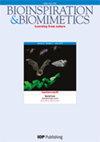Propulsive efficiency of spatiotemporally asymmetric oscillating appendages at intermediate Reynolds numbers.
IF 3.1
3区 计算机科学
Q1 ENGINEERING, MULTIDISCIPLINARY
引用次数: 0
Abstract
Many organisms use flexible appendages for locomotion, feeding, and other functional behaviors. The efficacy of these behaviors is determined in large part by the fluid dynamics of the appendage interacting with its environment. For oscillating appendages at low Reynolds numbers, viscosity dominates over inertia, and appendage motion must be spatially asymmetric to generate net flow. At high Reynolds numbers, viscous forces are negligible and appendage motion is often also temporally asymmetric, with a fast power stroke and a slow recovery stroke; such temporal asymmetry does not affect the produced flow at low Reynolds numbers. At intermediate Reynolds numbers, both viscous and inertial forces play non-trivial roles---correspondingly, both spatial and temporal asymmetry can strongly affect overall propulsion. Here we perform experiments on three robotic paddles with different material flexibilities and geometries, allowing us to explore the effects of motion asymmetry (both spatial and temporal) on force production. We show how a flexible paddle's time-varying shape throughout the beat cycle can reorient the direction of the produced force, generating both thrust and lift. We also evaluate the propulsive performance of the paddle by introducing a new quantity, which we term "integrated efficiency". This new definition of propulsive efficiency can be used to directly evaluate an appendage's performance independently from full-body swimming dynamics. Use of the integrated efficiency allows for accurate performance assessment, generalization, and comparison of oscillating appendages in both robotic devices and behaving organisms. Finally, we show that a curved flexible paddle generates thrust more efficiently than a straight paddle, and produces spatially asymmetric motion---thereby improving performance---without the need for complex actuation and controls, opening new avenues for bioinspired technology development.中等雷诺数下时空不对称振荡附肢的推进效率。
许多生物利用灵活的附肢进行运动、进食和其他功能行为。这些行为的效果在很大程度上取决于附肢与其环境相互作用的流体动力学。对于低雷诺数下的摆动附肢,粘滞性比惯性占优势,附肢运动必须在空间上不对称才能产生净流。在高雷诺数下,粘滞力可以忽略不计,附肢运动通常也是时间不对称的,动力冲程快,恢复冲程慢;在低雷诺数下,这种时间不对称不会影响产生的流动。在中等雷诺数时,粘性力和惯性力都起着非同小可的作用--相应地,空间和时间的不对称会对整体推进力产生强烈影响。在这里,我们对三种具有不同材料柔性和几何形状的机器人桨进行了实验,从而探索了运动不对称(空间和时间)对力产生的影响。我们展示了柔性桨在整个节拍周期中随时间变化的形状如何调整产生力的方向,从而产生推力和升力。我们还通过引入一个新量(我们称之为 "综合效率")来评估桨的推进性能。这种推进效率的新定义可用于直接评估附属装置的性能,而不受全身游泳动力学的影响。使用综合效率可以对机器人装置和行为生物的摆动附肢进行准确的性能评估、归纳和比较。最后,我们展示了弯曲的柔性桨比直的桨更有效地产生推力,并产生空间不对称运动--从而提高性能--而不需要复杂的驱动和控制,这为生物启发技术的发展开辟了新途径。
本文章由计算机程序翻译,如有差异,请以英文原文为准。
求助全文
约1分钟内获得全文
求助全文
来源期刊

Bioinspiration & Biomimetics
工程技术-材料科学:生物材料
CiteScore
5.90
自引率
14.70%
发文量
132
审稿时长
3 months
期刊介绍:
Bioinspiration & Biomimetics publishes research involving the study and distillation of principles and functions found in biological systems that have been developed through evolution, and application of this knowledge to produce novel and exciting basic technologies and new approaches to solving scientific problems. It provides a forum for interdisciplinary research which acts as a pipeline, facilitating the two-way flow of ideas and understanding between the extensive bodies of knowledge of the different disciplines. It has two principal aims: to draw on biology to enrich engineering and to draw from engineering to enrich biology.
The journal aims to include input from across all intersecting areas of both fields. In biology, this would include work in all fields from physiology to ecology, with either zoological or botanical focus. In engineering, this would include both design and practical application of biomimetic or bioinspired devices and systems. Typical areas of interest include:
Systems, designs and structure
Communication and navigation
Cooperative behaviour
Self-organizing biological systems
Self-healing and self-assembly
Aerial locomotion and aerospace applications of biomimetics
Biomorphic surface and subsurface systems
Marine dynamics: swimming and underwater dynamics
Applications of novel materials
Biomechanics; including movement, locomotion, fluidics
Cellular behaviour
Sensors and senses
Biomimetic or bioinformed approaches to geological exploration.
 求助内容:
求助内容: 应助结果提醒方式:
应助结果提醒方式:


